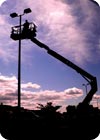
Eighty-three new video cameras provide the U.S. Department of Energy’s Pacific Northwest National Laboratory with wireless exterior campus coverage. Pole-mounted wireless cameras saved nearly $5 million in project costs. The new coverage boosts staff safety and security and provides remote assessment capabilities.
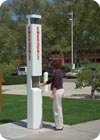
Fourteen emergency call stations strategically located throughout the PNNL campus provide a direct audio link to the Operations Center to report emergencies.
At Pacific Northwest National Laboratory (PNNL), safety and security personnel can respond to scenarios just like this, aided by a new campus public safety camera system. With strategically placed cameras, emergency call stations and a campus-wide outdoor wireless mesh network, the system integrates visual, audio and data feeds over a one-square-mile area of parking lots, pedestrian areas and facility perimeters. The result: a cohesive system that improves outdoor physical security, safety and emergency response throughout the campus.
While it would be irresponsible to claim that such a system could have prevented the recent shootings at Virginia Tech and NASA, the PNNL installation improves the Laboratory’s ability to respond to such an event. The unobtrusive system helps maintain the open, welcoming feel of the campus, while providing a “virtual fence” that provides continuous wireless connectivity among buildings and pinpoints any unauthorized attempted wireless access.
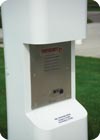
Emergency call stations also serve as a resource for information and general assistance.
Integrated Video Monitoring
Metropolitan and campus WiFi networks are becoming more common, but are typically used for data only. And video is often limited to a few fixed locations, typically focused on building entrances and other high-traffic areas. But as Cynthia Freschi of North American Video stated in the March issue of Security Magazine, what makes centralized video monitoring so attractive is the ability to view data and manage an entire network of security devices from a single location, anywhere on the network. It’s a significant step beyond centralized alarm monitoring and event management, she pointed out, because it provides live visual confirmation of an incident.In October, PNNL became the first federal government organization in the country to implement Cisco’s Aironet 1500 wireless mesh system in a comprehensive large-scale video, voice and data application. The $2.3 million system marked the culmination of two years of planning, design, approvals and installation.
Pacific Northwest National Laboratory is a Department of Energy Office of Science laboratory where 4,200 staff members conduct research in energy, environment, fundamental science and national security. The main campus in Richland, Wash., includes over 35 buildings and facilities spread over a large area. Similar to most universities, the open campus environment allows anyone, including 2,000 visitors annually, to approach any area, though entrance to all buildings is strictly controlled.
Internal reviews had indicated the need for enhanced safety and security assessment capabilities throughout PNNL, especially in facility exteriors and parking lots.
“This dovetailed with one of our goals to establish a campus-wide video capability and link it to an upgraded security operations center. We needed a multifunctional, outdoor camera system that was compatible with our internal wireless network and would work on a widely dispersed campus with many trees and line-of-sight obstacles. Working with consultants, we designed an installation consisting of 83 video cameras and 14 emergency call stations that run on an outdoor wireless mesh network. The system also feeds visuals to the operations center from a pre-existing set of 30 fixed cameras at building entrances,” said Jerry Johnson, chief information officer at the U.S. Department of Energy’s Pacific Northwest National Laboratory.
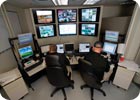
Encrypted video and audio feed into the new operations center where six 42-inch flat-panel monitors display multiple images per panel.
POLE-MOUNTED WIRELESS WONDER
The cameras are mounted on light poles and send encrypted signals to receivers mounted on the rooftops of nearby buildings. The tilt-pan-zoom cameras offer 365-degree fields of view and can be reconfigured easily as the campus grows and changes. The wireless mesh network is self- healing, meaning if any wireless transceivers were to fail, the network would automatically reconfigure itself for the optimum connection. Video and audio feed into a new, digital-based operations center, where six 42-inch flat-panel monitors display multiple images per panel.Though the cameras capture images when sensing movement, like banks and mini-marts do, they are not used for ongoing real-time surveillance – except when someone presses an emergency call button on a station. When that happens, the Voice over IP-based system immediately contacts the security operations center, brings up video of the area and opens a two-way intercom. Security staff can quickly view the situation remotely and talk with the person requesting help, making an informed decision about how to respond – whether dispatching campus security personnel or contacting 911 emergency services.
When security personnel need to react to a situation such as an alarm, broken window or theft, they can access stored images for information. “A month after the camera system was installed, security staff noticed that a 3-foot-tall walkway light near the parking lot had been knocked over during the weekend. Searching wide-range video camera footage, staff quickly pinpointed the problem – an employee’s car backing into the light. Though the license plate was obscured at that angle, the footage showed that the incident was an accident, not vandalism,” said Cameron Andersen, chief security officer at PNNL.
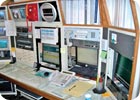
PNNL relocated its operations center to a centralized campus location and replaced its analog equipment with a wireless digital system.
Growth potential
The system’s flexibility makes it easy to expand. PNNL is planning to extend the operations center communications to hand-held devices like PDAs, pagers and cell phones. This will allow staff to send incoming data to power operators, building managers, campus security officers and others who are constantly on the move. In an emergency, it will help alert employees who are traveling between buildings.The wireless mesh network opens the door to other technologies and applications, such as tracking inventory and sensitive property using radio-frequency identification. PNNL is also considering granting limited network access to police and fire personnel en route, listing the types of chemicals in a building where there is a fire, for example.
“The system at PNNL has gained attention from other government laboratories and companies. Cisco is applying lessons learned from the PNNL system to other customers while it continues to work with PNNL to make system enhancements. With the system in place, safety and security personnel are better equipped to respond when needed, and employees have told us they feel safer,” said Anderson.
About the Source
Security Magazine thanks Cameron Andersen, chief security officer, and Jerry Johnson chief information officer at the U.S. Department of Energy’s Pacific Northwest National Laboratory in Richland, Wash. Visit the Web site atwww.pnl.govSIDEBAR: Thinking About a Wireless Integrated Video System?
Implementing a system of this magnitude presents many technical and management challenges. Some recommendations:-
Thoroughly assess your needs.
“Talk with people in security, safety, emergency preparedness and property protection to understand their needs. Benchmark existing systems that have features you need,” Cameron Andersen, chief security officer at the U.S. Department of Energy’s Pacific Northwest National Laboratory.
-
Involve information technology and engineering staff at the earliest possible stage.
“It’s easier to identify and address challenges up front rather than after you’ve invested time and money in system design and integration. For example, we abandoned our initial plan to use solar power at the light poles once it became apparent that the required battery enclosure would be too large,” said Jerry Johnson, chief information officer at the U.S. Department of Energy’s Pacific Northwest National Laboratory.
-
Get management buy-in early in the process.
“Chief executives typically care about costs, benefits, risk avoidance and future expandability. A key selling point was that the system provides a significant cost/risk benefit for a campus that sees 5,000 or more employees and visitors annually, any of who can bring their personal troubles to work with them. Executives also appreciated the $5 million savings in wireless connections, avoided by not installing new conduit and cable for each camera and call station,” said Johnson and Anderson of the system.
-
Use credible, experienced vendors to help you design and package a system.
“After our security staff laid out a conceptual design for the best camera coverage, a security system integration consultant validated the design and specified the necessary equipment and infrastructure,” said Anderson.
-
Communicate with staff.
“Some employees initially were concerned that the cameras would be used to document their activities and get them in trouble. We used our company publications to familiarize staff with the systems before, during and after installation. Employees attended open houses at the operations center, where they saw that the video images were not used for surveillance,” said Anderson.

